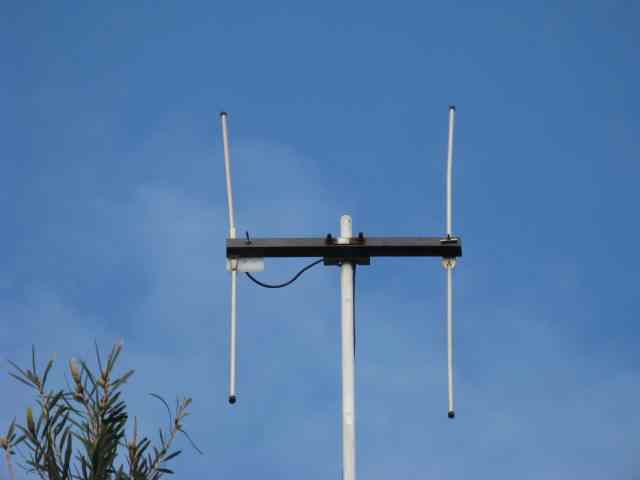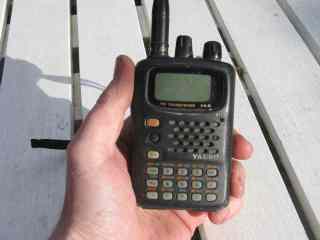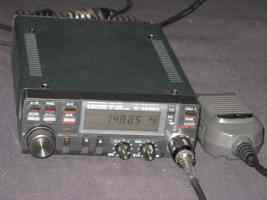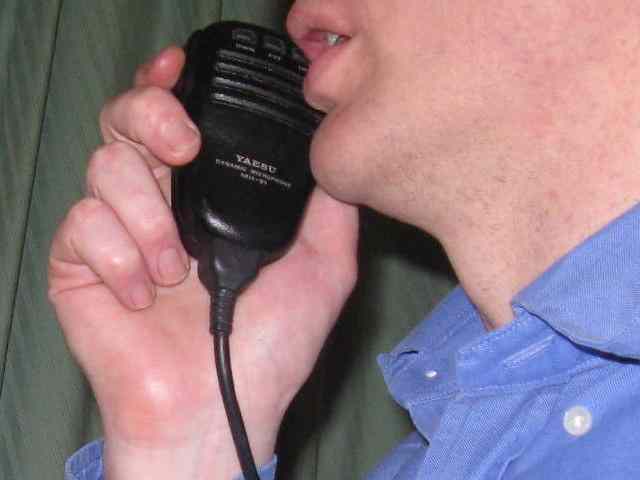

Return to VK3YE beginner and general articles
|
A VHF/UHF primer
 Propagation
Unlike shortwave (HF) bands, which are good for world-wide radio
communication, the VHF frequencies are best at providing reliable
coverage of local areas. Depending on factors such as your location
and antenna height, distances of between about 25 and 100 kilometres
can be readily covered with modest power and simple antennas.
While not quite 'line-of-sight', VHF/UHF signals are attenuated
(reduced in strength) by obstructions such as city buildings and
hills. This means that stations operating at higher altitudes
are likely to have stronger signals than those transmitting from
valleys. You will find that seventy centimetres provides similar
coverage to UHF CB equipment while two metres often permits slightly
longer distances to be covered.
While there are some differences between daytime and nightime
radio conditions on VHF/UHF, they are far less marked than the
variations experienced on HF bands such as 80 metres. The furthest
distances on VHF/UHF are usually covered either early in the morning,
or after dusk. At these times (particularly in the summer), tropospheric
ducting can extend your transmitting range to several hundred
kilometres. This means that you will be able to talk beyond your
local area, and reach distant repeaters. VHF/UHF propagation is
influenced by weather conditions; inversions in the troposphere
give rise to long distance VHF/UHF contacts. During these occasions,
the difference between VHF and UHF can be quite marked, and there
are times when long distances can be spanned on 70cm, but not
on 2 metres.
Equipment
A wide range of equipment is available for the VHF/UHF FM operator. Because of the popularity of two metres there is more VHF equipment around. In some areas, seventy centimetre activity is sparse, and few repeaters exist. If you live in the country, or are on a limited budget, I'd suggest that two metres be chosen as your first band.
Today's amateurs are spoiled with low-cost VHF equipment. At one time even a basic mobile 2 metre transceiver cost a week's wage or more, and many with a budget started with secondhand gear.
 These days, thanks to cheaper electronics and our strong dollar, new gear has become much cheaper. Nothing exemplifies this more than the cheap Chinese-made handheld transceivers now available on eBay for under $100, though even the familiar brands cost less than previously. Especially in view the of the longer warranties some suppliers offer, new equipment offers better value than it used to. Still, especially with multi-mode gear, you may still be able to save by buying used. This gear can be diverse, ranging from purpose amateur equipment to modified commercial gear, such as the famous Phillips FM900. You may occasionally see very old crystal-controlled equipment though this should be avoided due to its limited range of frequencies and absence of features like CTCSS (subtone) and DTMF (touch tone microphone) that some repeaters and linking modes (such as IRLP) employ.
 Whether to buy a hand-held or mobile transceiver is up to you. Hand-held equipment may have poor receivers (particularly apparent in inner-city areas near pager transmitters) and the in-built battery packs often flatten mid-QSO. The small antennas supplied with hand-held transceivers are normally quite inefficient. On the other hand, various accessories such as speaker-microphones, larger battery packs and antennas can make the hand-held suitable for both home and mobile operation. Mobile transceivers are capable of greater power output, and are good for home station operation in conjunction with a 13.8 volt power supply and outdoor antenna. While most operate FM only, some include SSB and CW cababilities. If you wish to use amateur satellites, or experiment with long-distance SSB operation, a multi-mode transceiver should be seriously considered.
Purchasing equipment
Websites like eHam have reviews that may help decide on the one you want. Word of mouth at radio clubs or on air is also important; someone else is sure to be considering
buying or has just purchased equipment.
New and used amateur equipment is obtainable from commercial suppliers, Amazon, private sellers (see eBay or amateur classifieds sites), and from junk sales or hamfests. As expected prices vary;
some prefer the warranty support of a local authorised dealer to the lower prices of an online purchase.
Antennas
The quality and performance of your antenna system is critical if you wish to do other than talk through local repeaters (which can get a bit boring after a while).
It is not hard to build an antenna, and experimentation with them is highly recommended. As VHF/UHF antennas are much smaller than those for 27 MHz CB, they are cheaper
and easier to erect. Like with UHF CB, vertical antenna polarisation is the norm for amateur FM operations.
 While many operate hand-held transceivers inside vehicles with no external antenna, operating range will improve with an antenna on the car roof. The most popular mobile antennas for two metres are 1/4 and 5/8 wavelength whips, preferably mounted in the centre of the roof. The longer antenna will normally deliver the better performance, but this may be short-lived; the low clearance of garage doors and multi-storey car parks are very good at damaging them! Seventy centimetre antennas are shorter, and some provide appreciable gain over a dipole. It is not necessary to drill holes to mount a mobile antenna; a wide range of mounting hardware and magnetic bases is available. Mobile antennas may either be purchased or home made. The performance of handheld transceivers can also be enhanced by adding a better antenna. A range of proprietry types are available, but they tend to be dearer than home-made devices. For most home stations, a 1/4 or 5/8 wave groundplane antenna will provide adequate onmidirectional coverage for both repeater and simplex operation. While it should be mounted as high as possible, attention should be paid to feedline losses, which increase with frequency. A loss of 3 decibels means that half the transmitter's power output never makes it to the antenna. Thinner coaxial cable (such as RG58) is lossier than thicker cables (RG8, RG213). While RG58 is acceptable for short cable runs on two metres, its use on 70 centimetres would be unwise unless you are prepared to live with substantial losses and reduced station performance. Constructional information on VHF/UHF antennas can be found in the ARRL Handbook. A simple groundplane for two metres comprises about 480mm of coathanger wire for the centre element and at least two similar lengths for drooping radials. When building antennas, observe safety precautions, such as not erecting them near power lines. To prevent corrosion at the antenna, dissimilar metals must not be in contact with each other. This is to ensure antenna longevity, and to reduce the risk of harmonics being radiated. Moisture should be prevented from entering the coaxial feedline. Waterproofing at the antenna feedpoint is essential, and various tapes and sealants are available for the job.
Items were chosen for likely usefulness and a satisfaction rating of 4/5 or better.
Repeaters
A lot of amateur (and CB) VHF/UHF communication takes place through repeater stations. Amateur repeaters consist of a receiver, transmitter, filters, and antenna. They are normally on hill tops. Repeaters receive a signal (often from a mobile or hand-held transceiver), and retransmit it on an adjacent frequency, so it can be heard over a much wider area. This means that with low power and compact antennas it is possible to communicate with people up to 100 to 150km away, provided that you are within the service area of your local repeater. Where linked via the internet using modes such as IRLP or Echolink communication to similar equipped repeaters all around the world becomes possible.
Repeaters are constructed and maintained by volunteers. If you intend using them, consider joining the local radio club or repeater group. The WIA website provides a listing of all amateur repeaters in Australia, the clubs/groups that erect them and their frequencies. It is a useful reference, and every active amateur should have one.
Most repeaters just require you to set your transmitter on one frequency and the receiver on another frequency. The spacing of these frequencies is standard (eg 1 MHz on 6 metres, 600kHz on 2 metres and 5 MHz on 70cm). Provided the transceiver is set correctly and your signal is strong enough you'll be retransmitted. The main exception is if the repeater uses a CTCSS subaudible tone. Unless your transceiver is very basic or very old you'll have the ability to set the tone to whatever the repeater requires. 91.5 or 123 Hz seem to be common frequencies. Repeaters with tone access have normally been fitted with it to reduce interference from spurious signals, though in some cases subtones may also control certain repeater functions such as retransmissions on another band.
The other form of repeater control is DTMF or touchtones similar to your phone. This is most common for internet repeater linking to switch links on or off, or switch to a particular node.
More on FM repeater operating
appears here. While analogue FM remains the cheapest mode to buy equipment for there are also digital mode repeaters using modes such as
DSTAR, C4FM or DMR. Repeater availability and activity varies by area and I suggest talking to local hams before spending a lot on equipment for a particular mode.
SatellitesNot all repeaters are on the ground. Amateurs also have satellites available for their use. The simplest work a bit like an FM repeater but allow contacts up to about 4000 km even with simple handheld equipment. Interested? Read the introduction and watch the demonstrations here. SSB
SSB is the most popular voice mode on HF but finds use on VHF and UHF band as well. It is more efficient than FM, allowing longer distance contacts for a given power output and antenna gain.
Remember that the forumula for the area of a circle is radius squared times pi? In radio that means that if you double your transmitting distance, such as possible by switching from FM to SSB,
that increases your coverage area by four times, all without the help of repeaters.
Another difference between SSB and FM is that SSB uses horizontally polarised antennas (like TV aerials in most areas) whereas FM antennas are all vertical. The right antenna polarisation at both ends is critical since working cross-polarisation greatly weakens signals. The most common VHF or UHF SSB antenna is a rotatable yagi. The more elements the better, though for the beginner seeking a quick project with worthwhile gain, four to eight elements on two metres is easy and cheap.
The type of activity you hear on VHF / UHF SSB is different to what you'll hear on VHF / UHF FM.
Radio amateurs are largely divided into three groups: ragchewers (or communicators), DXers (those who like working long distances) and technicians (the builders and experimenters). HF SSB contains a mix of ragchewers, DXers and a few technicians. VHF / UHF FM comprises mainly ragchewers, with a few of the other types. Whereas VHF / UHF SSB is dominated by DXers and technicians but is devoid of ragchewers.
That's why though VHF SSB has a reasonable number of adherents, most of the time activity from them is light, even in populated areas.
Instead VHFers have learned to confine their activity to certain times, such as early mornings or during field days, when the chance of working others is increased.
Making fewer contacts doesn't lessen their enjoyment; for the VHF, UHF and especially microwave DXer, one 1000 or 2000 kilometre contact is worth a hundred such
contacts on the 'easier' HF bands. Read more on VHF/UHF SSB here and watch the video below.
Band plans
To promote orderly usage of amateur bands, bandplans which set
aside frequencies for various modes and uses have been developed.
They are important to the beginner, as contacts will not be made
if you are transmitting on the wrong frequencies. Amateur bandplans
can be found on the WIA website.
VHF and UHF band plans are a bit like HF band plans in that at the very bottom frequencies is the Morse segment. A bit higher is SSB. But unlike HF, much larger
chunks of the VHF and UHF bands are channelised (25 kHz intervals) for FM, data and repeaters. Digital modes such as D-Star may occupy intermediate frequencies
in the FM segment. In addition, the wider UHF and microwave bands have large allocations for television.
Operating
Conversations (QSOs) can be initiated either directly, on a simplex
frequency (eg 146.500, 439.000 MHz), or via a repeater. In most
places, you have a better chance of success by calling on a repeater.
Do check that the frequency offset is switched in and correct
for the repeater you intend using; some use offsets different
to those specified in the Bandplan.
Assuming that the repeater is free, you may either call CQ, or
announce that you are listening. Though procedures vary between
states, the former is suggested as it corresponds to standard
practice on other bands, and more clearly announces your intention
(ie you want a contact!).
An effective means of making contacts is to call people immediately
after a conversation has ended. Alternatively, you could break
in to a QSO still in progress. This is permissible if you have
something to contribute to the discussion, or just want a quick
signal report, but it is probably wise not to make it a frequent
habit.
 Once contact has been established on a repeater, it is courteous to move to a simplex frequency if possible; this makes the repeater available to those unable to do so. Another reason why simplex operation is preferred is that repeaters have time-outs, so you could find yourself cut off if you enjoy long overs on repeaters. During the contact, bear in mind that there are a few topics that are not considered part of polite conversation on a public medium. These include religion, politics and matters involving financial gain. Those with more than one amateur in the family should take special care; announcing on the local repeater that 'the key is just under the doormat' is asking for trouble. Criminals have scanners, and your address is in the callbook! Don't be too disheartened if few respond to your calls. Although many monitor repeaters, comparatively few actually talk. A lot of amateurs do nothing other than talk to their narrow circle of mates; you will notice many little groups congregating on various frequencies, particularly in the larger cities. In the country, there are fewer amateurs, so this tendency is less apparent. Though there are still a few pockets of anti-Foundation licence sentiment around, those who harbour such feelings are gradually dying off. Despite the preceding comments, you will find that most amateurs you contact are courteous and helpful, though many are initially reticent in coming forward and picking up the microphone to talk to a new callsign. To get to know some of these people, it is recommended that you join a local radio club and participate in some of their activities. After an intitial flurry of activity, one's enthusiasm for local FM operating (particularly through repeaters) can quickly dissipate. Fortunately, even within the conditions of the Foundation licence, there is scope for a range of activities including packet radio, antenna construction, repeater DXing, contesting, QRP, foxhunting, portable operation and homebrewing (anything except transmitters). Participation in one or more of these facets of our hobby can be highly rewarding. The practical experience gained will also make it much easier to move to a higher grade of licence, as your interest develops.
Portable operating
Height is might on VHF, UHF and particularly microwaves. If your home isn't blessed with a clear outlook, operating portable is the next best thing.
The results can be particuarly gratifying when your expedition coincides with high activity, such as during a VHF Field Day or band opening.
For VHF / UHF, consider the following when selecting a site:
* Altitude (height above sea level and above surrounding land)
* A clear view in desired directions (especially for near line of sight microwave work)
A site nearest home will likely not be the best VHF / UHF site you'll ever visit. However it's handy having a nearby site you can get to at short notice for those after-work band
openings, field days where you can't be far from home or equipment testing purposes.
Equipment compactness is essential if you need to hand-carry gear to a site (eg the top of some lookouts). On the other hand if transmitting from a parked vehicle you can
afford heavier gear, higher power and more elaborate antennas. Some amateurs have even modified vehicles to be more suited to portable operating.
The most basic VHF / UHF portable setup is of course an FM handheld transceiver. However the limited antenna and lack of SSB will prove a major restriction, particularly
for VHF field day contests, where SSB is dominant.
The next step up might involve a QRP transceiver (eg an FT-817) and small yagis (2 to 6 elements) for 2 metres and 70 centimetres. Such a station is good for
contacts up to several hundred kilometres, as demonstrated in the video below.
Another move up involves better antennas, longer beams and possibly additional bands such as 6 metres, 23 centimetres and/or microwaves. At this stage it might be worth taking another amateur along to help with set up and operating. The bigger the station, the more demanding the power source, whether it be small batteries, large batteries, solar or a generator. Power is discussed in more detail (at least for smaller portable stations) in other articles on this site.
Digital modes
Computer-based digital modes can allow you to span amazing distances on VHF and UHF, even with modest antennas. Modes can include WSPR (which is basically a beaconing system
rather than an exchange with another station) to MSK144 and FT8 (where you have an exchange with another station but it's impersonal) to JS8 where you have a real conversation by by keyboard.
Even where SSB doesn't get through these modes often will. Experienced operators even bounce signals off the moon or meteors. Some video examples below.
Conclusion
This article has provided an introduction to VHF and UHF operating. Please see related items elsewhere on this site for more detail on facets such as
repeaters, internet repeater linking,
satellites and VHF/UHF SSB.
Many topics are also covered briefly in the video below.
It was updated and enlarged in 2012 and 2018.
|
Books by VK3YE
Ham Radio Get Started (USA)Australian Ham Radio Handbook (Aust) More Hand-carried QRP Antennas 99 things you can do with Amateur Radio Getting back into Amateur Radio Illustrated International Ham Radio Dictionary Make your Passion Pay (ebook writing)
All material on this site |